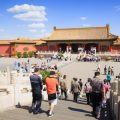Introduction to Britains Mysterious Stone Circles
Scattered across the rolling landscapes of Britain, enigmatic stone circles stand as silent sentinels to an ancient past. These age-old monuments, ranging from the iconic Stonehenge on Salisbury Plain to the lesser-known Castlerigg in Cumbria, have sparked curiosity and speculation for centuries. Erected during the late Neolithic and early Bronze Age, roughly between 3000 and 1200 BCE, these circles are woven deeply into the tapestry of British history and identity. Their enigmatic presence continues to captivate the imagination of locals, historians, and visitors alike, serving not only as archaeological relics but also as enduring symbols within British folklore and cultural consciousness. Despite countless studies, the true purpose behind their construction remains shrouded in mystery, ensuring that stone circles retain their place as some of Britain’s most fascinating and enduring enigmas.
2. Unravelling the Symbolism behind the Stones
The enigmatic stone circles scattered across Britain have long captivated both scholars and laypeople alike, their purpose shrouded in layers of myth and historical speculation. To ancient Britons, these monolithic structures were far more than mere markers in the landscape; they were imbued with potent symbolism that intertwined spiritual beliefs, astronomical observations, and social customs. Understanding the multifaceted meanings attributed to these stones offers a glimpse into the mindset of those who erected them millennia ago.
Spiritual Significance
For many ancient communities, stone circles served as sacred spaces where rituals and ceremonies were performed. The enduring nature of stone suggested permanence, linking the earthly realm with the eternal. It is widely believed that these circles were focal points for seasonal gatherings—moments when communities came together to honour deities, ancestors, or natural cycles. The act of encircling an open space with megaliths may have been symbolic of unity, protection, and continuity.
Astronomical Alignments
Beyond their spiritual resonance, stone circles often reveal careful alignment with celestial events. Many are oriented towards significant solar or lunar phenomena such as solstices and equinoxes, indicating a sophisticated understanding of astronomy among their builders. This alignment suggests that ancient Britons used these sites as calendars to mark time and anticipate agricultural seasons—an essential aspect of survival in prehistoric societies.
| Stone Circle | Celestial Alignment | Associated Event |
|---|---|---|
| Stonehenge | Northeast-Southwest Axis | Summer Solstice Sunrise |
| Avebury | Various Lunar Alignments | Lunar Standstill |
| Castlerigg | Easterly Alignment | Equinox Sunrise |
Cultural Resonance within Ancient British Society
The construction and maintenance of stone circles required considerable communal effort, reflecting not only technological prowess but also social cohesion. These monuments became markers of identity for local groups and may have served as neutral ground for trade, political gatherings, or dispute resolution. In this way, stone circles functioned as both physical and symbolic centres—a testament to shared values and collective memory.

3. The Art of Placement: Geography, Landscape, and Alignment
One of the most striking aspects of Britain’s ancient stone circles lies not only in their construction but also in their purposeful placement within the landscape. The builders of these enigmatic monuments did not select locations at random; rather, they demonstrated a sophisticated understanding of geography and a deep reverence for the natural world. Many stone circles were situated to take advantage of dramatic vistas—perched atop windswept hills, nestled within tranquil valleys, or positioned alongside rivers and lakes whose reflective surfaces may have enhanced ceremonial atmospheres.
Alignment with Natural Features
The relationship between stone circles and their surrounding environment is evident in their careful alignment with prominent natural features. For example, some circles frame distant mountains or align with the rising and setting sun over specific hilltops. These connections suggest that ancient Britons perceived the landscape itself as imbued with spiritual significance, selecting sites that harmonised human activity with the rhythms and contours of nature.
Astronomical Events and Sacred Calendars
Perhaps most compelling is the evidence for astronomical alignment. Several celebrated sites—such as Stonehenge and Avebury—are famously oriented towards solstices and equinoxes, serving as prehistoric observatories that marked the passage of time. Such alignments indicate that stone circles functioned as more than mere gathering places; they were integral to ritual calendars, agricultural cycles, and communal celebrations tied to celestial events. This fusion of earth and sky speaks to a worldview in which cosmic order was mirrored in terrestrial design.
Sacred Geography and Social Cohesion
Beyond practical considerations, the deliberate siting of stone circles may reflect an ancient sense of sacred geography—a mapping of mythic or ancestral memory onto the land. By placing monuments at nodal points where ley lines or other perceived energies converged, communities could assert collective identity and affirm ties to both place and tradition. In this way, the artful placement of stone circles across Britain not only shaped ritual life but also left an enduring imprint on the cultural landscape.
4. Rituals, Gatherings, and the Social Function
Stone circles in ancient Britain were far more than silent sentinels of stone; they were living spaces imbued with profound social and ritualistic significance. The concentric rings of megaliths did not merely serve as architectural wonders but formed the very heart of communal life for early Britons. Through archaeological findings and ethnographic parallels, it is increasingly evident that these enigmatic monuments hosted a wide array of gatherings—ranging from sacred rites to festivals marking the passage of seasons.
Ritual Assemblies and Sacred Acts
The placement and orientation of many stone circles suggest deliberate alignment with celestial events such as solstices and equinoxes. Such precision implies their use as ceremonial sites where communities would come together to observe the cycles of nature. These gatherings likely included offerings, music, dance, and feasting—ritual acts designed to honour deities, ancestors, or the changing year. The stones themselves may have functioned as witnesses to vows or as focal points for invoking blessings upon the land and its people.
Seasonal Festivals: Marking Time and Unity
In a landscape without written calendars, stone circles provided tangible markers for the turning of seasons. Major festivals—such as those associated with midsummer or midwinter—would have drawn people from miles around, fostering both spiritual connection and social cohesion. These occasions offered opportunities to reinforce kinship ties, settle disputes, and exchange goods or news. Below is an overview of how these gatherings might have been structured throughout the year:
| Festival | Approximate Timing | Likely Activities |
|---|---|---|
| Midwinter Solstice | December | Fire ceremonies, storytelling, feasting |
| Midsummer Solstice | June | Dancing, games, rituals celebrating fertility and abundance |
| Equinox Gatherings | March & September | Offerings to deities, community decision-making |
| Ancestral Commemorations | Varied (often autumn) | Remembrance rites, sharing of oral histories |
The Stone Circle as a Symbol of Identity
Beyond ritual observance, the construction and maintenance of stone circles fostered a sense of belonging and shared identity among ancient Britons. Participating in collective endeavours—whether erecting monoliths or preparing communal feasts—reinforced bonds within and between groups. The enduring presence of these circles in the British landscape continues to remind us that they were centres not only of ceremony but also of social unity; places where memory was made tangible in stone.
5. From Avebury to Callanish: Regional Variation and Local Identity
While the stone circles of Britain share a sense of mystery and grandeur, a closer inspection reveals pronounced regional distinctions in their design and purpose. From the monumental avenues of Avebury in southern England to the brooding majesty of Callanish on the Isle of Lewis, each region left its unique imprint on these ancient constructs, reflecting local traditions, beliefs, and social hierarchies.
The Southern Splendour: Avebury and its Landscape
In southern Britain, particularly Wiltshire, stone circles like Avebury are characterised by their vast scale and integration within an extensive ritual landscape. The sheer size of Avebury—encircled by a massive bank and ditch—suggests not only a ceremonial function but also a demonstration of communal strength and organisation. Here, the arrangement of stones, avenues, and nearby monuments such as Silbury Hill hints at elaborate ritual journeys, possibly rooted in local mythologies or seasonal observances unique to this fertile heartland.
Northern Expressions: Callanish and Beyond
Contrastingly, the stone circles of northern Britain—most famously at Callanish in the Outer Hebrides—reveal different priorities and cosmological concerns. The slender stones of Callanish are arranged in a cruciform pattern aligned with lunar cycles, suggesting an advanced knowledge of astronomy intertwined with local legend. These circles often stand in more isolated settings, echoing the rugged landscapes and perhaps reflecting smaller kin-based societies where identity was closely tied to land and ancestry.
Distinctive Materials and Construction Techniques
The choice of stone itself further accentuates regional identities. In Cornwall and Cumbria, for instance, builders often utilised locally sourced granite or slate, incorporating natural shapes rather than meticulously dressing each stone. This pragmatic approach speaks to both the available resources and the cultural inclination towards harmonising built forms with the surrounding environment—a practice still evident in British vernacular architecture today.
Societal Structures Reflected in Stone
The diversity of stone circles across Britain mirrors variations in social structure. Large-scale complexes like those at Avebury may indicate powerful chieftains or priestly classes orchestrating collective efforts, while more modest circles scattered through Scotland could represent gatherings of extended families or clans. These differences illuminate how regional identities were celebrated through monument building—a tradition that fostered community cohesion while marking territory and ancestry for generations to come.
6. Modern Perspectives: Conservation, Folklore, and Heritage
In contemporary Britain, stone circles are no longer mere relics of a distant past but cherished symbols woven into the cultural fabric of the nation. The approach to their preservation is underpinned by a sense of collective responsibility, as these ancient monuments are recognised as irreplaceable links to the country’s prehistoric heritage. Organisations such as English Heritage and Historic Environment Scotland play pivotal roles in safeguarding these sites, employing careful conservation techniques that respect both the stones’ integrity and the landscapes they inhabit.
Beyond their physical preservation, stone circles occupy a prominent place in British folklore and popular imagination. Legends abound—from tales of petrified dancers at the Merry Maidens in Cornwall to stories of druids and faeries gathering at Avebury—imbuing these enigmatic structures with a mystical aura that continues to captivate locals and visitors alike. Annual events, solstice celebrations, and guided walks often draw upon these traditions, ensuring that the folklore surrounding stone circles remains vibrantly alive.
Their significance as heritage sites extends beyond archaeology or legend; stone circles have become emblematic of British identity and continuity. They offer a tangible connection to ancestral ways of life and worldviews, inviting reflection on the passage of time and humanity’s relationship with nature. As educational resources, they foster curiosity and scholarship among new generations, while as tourist attractions, they support local economies and promote regional pride.
Yet, modern engagement with stone circles is not without its challenges. Issues such as erosion from foot traffic, vandalism, and the impact of development projects necessitate ongoing dialogue about best practices for access and stewardship. The balancing act between making these sites accessible to the public and protecting them for future generations is a matter of national debate—a testament to their enduring importance in British society.
Ultimately, stone circles remain powerful touchstones in Britain’s landscape—sites where ancient mysteries meet modern meaning. Their continued conservation and celebration reflect not only respect for the past but also an enduring commitment to cultural heritage that is distinctly British in spirit.


